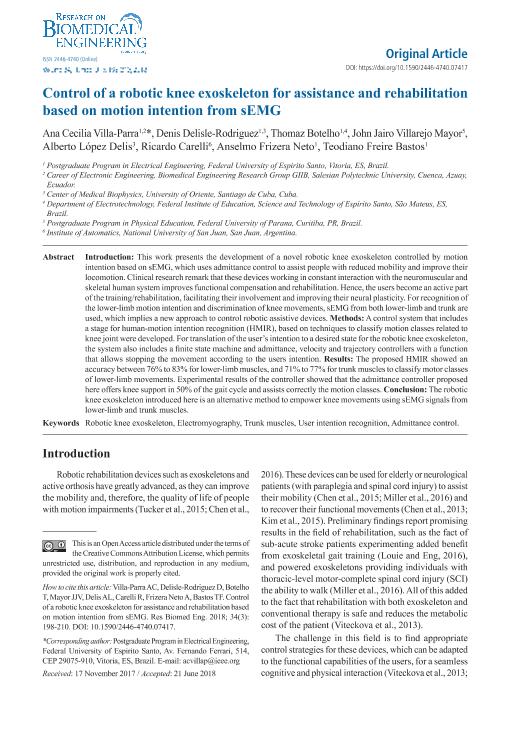Mostrar el registro sencillo del ítem
dc.contributor.author
Villa Parra, Ana Cecilia
dc.contributor.author
Delisle Rodriguez, Denis
dc.contributor.author
Botelho, Thomaz
dc.contributor.author
Mayor, John Jairo Villarejo
dc.contributor.author
Delis, Alberto López
dc.contributor.author
Carelli Albarracin, Ricardo Oscar

dc.contributor.author
Neto, Anselmo Frizera
dc.contributor.author
Bastos, Teodiano Freire
dc.date.available
2019-11-19T21:47:58Z
dc.date.issued
2018-09
dc.identifier.citation
Villa Parra, Ana Cecilia; Delisle Rodriguez, Denis; Botelho, Thomaz; Mayor, John Jairo Villarejo; Delis, Alberto López; et al.; Control of a robotic knee exoskeleton for assistance and rehabilitation based on motion intention from sEMG; Sociedade Brasileira de Engenharia Biomédica; Research on Biomedical Engineering; 34; 3; 9-2018; 198-210
dc.identifier.issn
2446-4732
dc.identifier.uri
http://hdl.handle.net/11336/89234
dc.description.abstract
Introduction: This work presents the development of a novel robotic knee exoskeleton controlled by motion intention based on sEMG, which uses admittance control to assist people with reduced mobility and improve their locomotion. Clinical research remark that these devices working in constant interaction with the neuromuscular and skeletal human system improves functional compensation and rehabilitation. Hence, the users become an active part of the training/rehabilitation, facilitating their involvement and improving their neural plasticity. For recognition of the lower-limb motion intention and discrimination of knee movements, sEMG from both lower-limb and trunk are used, which implies a new approach to control robotic assistive devices. Methods: A control system that includes a stage for human-motion intention recognition (HMIR), based on techniques to classify motion classes related to knee joint were developed. For translation of the user’s intention to a desired state for the robotic knee exoskeleton, the system also includes a finite state machine and admittance, velocity and trajectory controllers with a function that allows stopping the movement according to the users intention. Results: The proposed HMIR showed an accuracy between 76% to 83% for lower-limb muscles, and 71% to 77% for trunk muscles to classify motor classes of lower-limb movements. Experimental results of the controller showed that the admittance controller proposed here offers knee support in 50% of the gait cycle and assists correctly the motion classes. Conclusion: The robotic knee exoskeleton introduced here is an alternative method to empower knee movements using sEMG signals from lower-limb and trunk muscles.
dc.format
application/pdf
dc.language.iso
eng
dc.publisher
Sociedade Brasileira de Engenharia Biomédica
dc.rights
info:eu-repo/semantics/openAccess
dc.rights.uri
https://creativecommons.org/licenses/by-nc-sa/2.5/ar/
dc.subject
ADMITTANCE CONTROL
dc.subject
ELECTROMYOGRAPHY
dc.subject
ROBOTIC KNEE EXOSKELETON
dc.subject
TRUNK MUSCLES
dc.subject
USER INTENTION RECOGNITION
dc.subject.classification
Control Automático y Robótica

dc.subject.classification
Ingeniería Eléctrica, Ingeniería Electrónica e Ingeniería de la Información

dc.subject.classification
INGENIERÍAS Y TECNOLOGÍAS

dc.title
Control of a robotic knee exoskeleton for assistance and rehabilitation based on motion intention from sEMG
dc.type
info:eu-repo/semantics/article
dc.type
info:ar-repo/semantics/artículo
dc.type
info:eu-repo/semantics/publishedVersion
dc.date.updated
2019-10-17T14:56:10Z
dc.identifier.eissn
2446-4740
dc.journal.volume
34
dc.journal.number
3
dc.journal.pagination
198-210
dc.journal.pais
Brasil

dc.journal.ciudad
Río de Janeiro
dc.description.fil
Fil: Villa Parra, Ana Cecilia. Universidade Federal do Espírito Santo; Brasil. Universidad Politécnica Salesiana; Ecuador
dc.description.fil
Fil: Delisle Rodriguez, Denis. Universidade Federal do Espírito Santo; Brasil. Universidad de Oriente; Cuba
dc.description.fil
Fil: Botelho, Thomaz. Universidade Federal do Espírito Santo; Brasil
dc.description.fil
Fil: Mayor, John Jairo Villarejo. Universidade Federal do Paraná; Brasil
dc.description.fil
Fil: Delis, Alberto López. Universidad de Oriente; Cuba
dc.description.fil
Fil: Carelli Albarracin, Ricardo Oscar. Consejo Nacional de Investigaciones Científicas y Técnicas. Centro Científico Tecnológico Conicet - San Juan. Instituto de Automática. Universidad Nacional de San Juan. Facultad de Ingeniería. Instituto de Automática; Argentina
dc.description.fil
Fil: Neto, Anselmo Frizera. Universidade Federal do Espírito Santo; Brasil
dc.description.fil
Fil: Bastos, Teodiano Freire. Universidade Federal do Espírito Santo; Brasil
dc.journal.title
Research on Biomedical Engineering
dc.relation.alternativeid
info:eu-repo/semantics/altIdentifier/doi/http://dx.doi.org/10.1590/2446-4740.07417
dc.relation.alternativeid
info:eu-repo/semantics/altIdentifier/url/http://ref.scielo.org/p4hpq5
dc.relation.alternativeid
info:eu-repo/semantics/altIdentifier/url/https://www.rbejournal.org/article/doi/10.1590/2446-4740.07417
Archivos asociados
